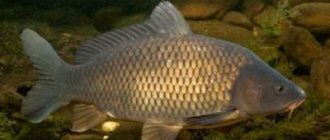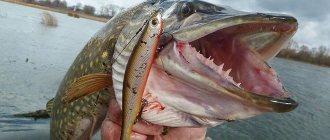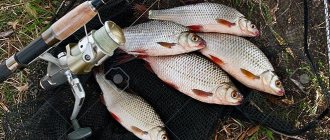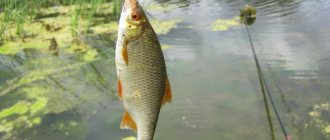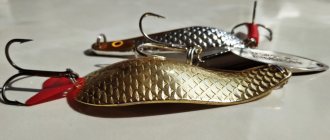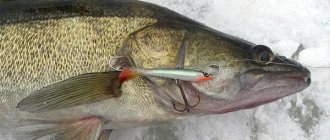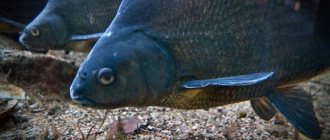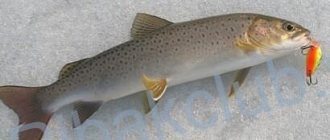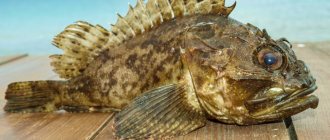Roach fishing in winter holds a special place in the heart of every winter angler. When neither bream, nor crucian carp, nor even perch are caught, the roach helps out. But this does not mean that winter fishing for roach is a simple activity. Sometimes in winter it is possible to catch a lot of this fish from the ice without preparation, but such luck is rare, and the catches usually contain roach weighing up to 120 grams.
To catch roach constantly, you need to know the subtleties and some biological features, and use as much knowledge as possible. The silvery beauty does not hibernate in winter, alternating periods of high and low feeding activity. Roach is present in large numbers in water bodies, but not everyone catches it in winter. The fisherman needs to find a feeding school or entice inactive fish to bite.
Features of winter behavior
You can catch roach in winter. You just need to understand some of the biological features of its behavior. Fishing for roach in winter is changeable, but this is not to say that this fish is unpredictable. Capricious - yes, probably. The strong weather dependence of roach, especially in winter, has long been known.
Factors influencing winter bite:
- Time of year, seasonality phenomena.
- Atmospheric pressure, weather and wind.
- The type of reservoir and its specifics - depths, dimensions, food supply, plankton migrations.
- The region - our country is large, and the habitat conditions of this fish vary. Taran, serka - on the Don, vobla on the Volga, chebak in Siberia, sorog in the northern regions - all these names belong to the same species.
- What do roaches eat in winter in this body of water?
The influence of weather on roach biting
In winter, roach bite unstably, but it is easy to catch if you know the habits and stopping points on a particular body of water. And the reason for this is the weather and water conditions. Underwater currents, water temperature, movement of zooplankton masses, dissolved oxygen levels - everything affects the bite. It has been noticed that any fish bites better in winter when the weather is constant, without sudden jumps and changes. It should be taken into account that in cold water fish do not need a lot of food, since calorie consumption with a slow metabolism is small.
At what pressure does a roach bite better in winter?
The fish feels great at both high and low atmospheric pressure. Atmospheric pressure does not directly affect its condition - this is a myth. Pressure is simply a measure of atmospheric changes. As the weather changes, the situation in the reservoir also changes, and feeding cycles shift. When the bite is bad, you should complain not about the weather, but about the wrong fishing tactics. With sudden changes, the fish simply do not have time to adapt to the new conditions.
The biting at this time can either stop or resume with renewed vigor. The fish may not bite even in seemingly fine weather - simply because it has already eaten enough the day before. In some weather you need to feed and wait until the active fish gathers on its own. in the other - look for a school standing still, slip the bait under the fish’s nose.
In what winter weather does roach bite best?
The best atmospheric pressure for catching roach is constantly high, average or slightly below normal. The main thing is that there are no sudden jumps. Uniform, gradual changes are acceptable. The soroga is active all winter. Therefore, in January and February, when other fish are not particularly active, fishing can be very successful, as long as weather conditions permit.
Wind influence in winter
The wind also affects the bite. In strong and gusty winds, fish are often not caught. This is more relevant for large bodies of water. Even thick ice in strong winds on reservoir areas moves in waves, which are noticeable only by fluctuations in the water level in the hole. At such moments the bite is poor or non-existent.
For biting, you need quiet, stable weather, without surges in atmospheric pressure, sudden increases and decreases, and without strong gusty winds. Other weather factors are not so important - fish are caught both in the thaw and in twenty-degree frost, day and night.
Where to look for roach in winter
Winter fishing for sorog depends greatly on the fishing location. Successful fishing for this fish is the result of an active search. Three main pillars of winter roach fishing:
- The weather is suitable.
- The right place to fish.
- Selection of gear, baits and fishing techniques.
Search and catch tactics
Ice fishing for roach in winter is based on a search strategy. If in small rivers this fish is present almost everywhere in certain quantities, then in large reservoirs and lakes it migrates quite actively in winter in search of food and oxygenated water.
Favorite habitats in reservoirs
Sorozhka is a schooling fish. And it is divided into flocks according to age and size. The size of the fish that bites is the one that stands under the hole. If you start catching small roach while fishing, we move to another place or wait for the next flock to arrive. To catch a large roach in winter, you need to find it. Adult roach are not as lively as small ones, and stay in separate small schools deeper.
Catching roach in winter with a feeder
When fishing in stagnant water, lumps of bait and bunches of food bloodworms can be thrown directly into the hole, but if the depth is large, the bait will still reach the bottom, scatter over a large area and there will be no real effect from such bait, so it is better to use such bait as additional. And it is better to do the main feeding with the help of a roach feeder in winter, which will bring the bait to the very bottom and to the right place, without scattering in different directions from the fishing spot.
Such feeders are called dump trucks, because the bait falls out of the feeder itself with a sharp tug on the fishing line tied to the feeder, the bottom folds back and the contents spill out. In still water, the dump feeder can be lowered directly into the same hole, into which you can then throw the fishing rod after pulling out the feeder. As a result, the roach will approach the hook itself with bait or attachment.
It’s a completely different story with the use of feeders when catching roach in the winter on the current, for the simple reason that the bait will be carried away from the fishing site, so you need to feed it differently. When fishing for roach on the current in winter, you need to feed the roach upstream from the fishing spot. It is better to determine at what distance to drill a feeding hole from the fishing hole experimentally; you may have to drill several holes one after another, the distance depends on the strength of the current. The main thing is that the hooks with bait fall into the train of bait washed out by the current and thrown out of the feeder.
When fishing for roach in the current in the winter, you can also use a regular feeder as for fishing in the summer, from which the bait is gradually washed out by the current. Such a feeder looks like a net or container with mesh walls or holes, weighted down with a load so that it does not blow away. In winter, the feeder is lowered from the ice to the bottom on a thick fishing line, also upstream and remains there for the entire fishing period. Under the influence of the flow of water, the bait is washed out from such a feeder gradually and for quite a long time, which creates a constant trail of bait that attracts large roaches and other fish in winter. When the bite weakens, you can shake the feeder a little, lifting it up and down.
Winter habitats
In the cold season, roaches move to deep areas, away from the shore. The optimal fishing depth is up to 5-6 meters. This fish doesn't stand any deeper. The parking location also depends on the amount of oxygen - the flock will not enter musty shallow muddy backwaters.
Catching roach in winter will be successful in large areas with a slightly silted or hard bottom with numerous irregularities and changes at depths of 4-5 meters, on long exits from pits. The fish avoids strong currents, but likes to stand next to it in calm water. The main thing is that there is food, so there will be no track on bare sand either.
Winter parking areas
- The largest roach, weighing up to a kilogram, lives in deep holes with underwater vegetation and colonies of dracena shells, often next to schools of bream. A mature sorog feeds on these shells, crushing the shells with its pharyngeal teeth.
- The number of such trophies is small, and it is advisable to hunt for them if the specific habitat is known. Therefore, the main fishing object is a medium-sized fish, weighing 200-400 grams.
- In winter, roach gather in large schools, and if you find an approximate square of its habitat, you can fish here all winter. In such places, fishing towns of tents are formed. True, due to the rotting of bait residues (or other factors), the fish can leave at any moment. Therefore, some fishermen prefer to search on their own, rightly hoping for larger specimens.
On small rivers
Finding roach in winter on small rivers is easier than on large reservoirs, due to the simple determination of the approximate bottom topography. And there are simply no vast areas for migration here. Holes are drilled in deep-water areas with vegetation, exits from pits, in places with reverse flow, and in sinkholes under a steep bank. Small rivers are promising places for fishing. Local fishermen, who thoroughly know their home rivers, catch roach in such treasured places all winter.
Promising places to search on the river
On reservoirs and lakes
Catching large roach in winter is most successful in large reservoirs or lakes. Here the fish gather in huge schools; the fisherman can count on a very decent catch if he finds these clusters. For example, catching rams in winter on the Tsimlyansk Reservoir, in a favorable situation, no longer resembles fishing, but commercial fishing. This usually happens already in March, when huge flocks, preparing for spawning, come closer to the shore and begin to feed intensively.
Where to look for roach in the reservoir in winter:
- In areas with a depth of up to 6 meters, with drops and shelters.
- Soroga loves flooded beds of streams, rivers, pits and ditches.
- If such an anomaly is found in a long, flat area, do not doubt that this place will gather the entire flock from nearby water areas.
- Good places are large patches of medium depth, rich in food, rising above the prevailing bottom topography far from the shores.
Catching roach on a natural lake in winter is no different. But if the reservoir is not shallow, then you should look close to the shore, at an acceptable depth or near the islands. Of course, this is not a complete list of places where you can catch roach in large bodies of water in winter. Due to the sheer size of our country, the variety of possible conditions is great. We have noted the main trends, but the details need to be clarified when directly preparing for winter fishing, using information from forums or from local experts.
Places to look in winter
On ponds and quarries
Catching roach in quarries, especially old ones in which an ecosystem has already formed, can also be successful in winter. But here it is important to take into account some features. Firstly, in quarries it is impossible to determine the bottom topography by external signs; under a steep bank there may be a shoal, and under a flat bank there may be a deep hole. Such reservoirs were formed artificially. Here an echo sounder or depth gauge will come to the aid of the fisherman. Winter gear for roaches in the still water of a quarry needs to be as light and inconspicuous as possible - after all, the water here is usually clean, especially if the bottom is rocky.
Catching roach in winter is also possible in a pond, the main thing is that it is found there. Fishing can be successful even in a very small pond, the main thing is to choose the right keys. Pond conditions are different in winter. The general pattern is that the largest roach will always occupy the best places for it, simply because there are not as many of them in the pond as in reservoirs. And if you find such a place, you can count on a significant catch.
Tackle for winter fishing for roach
Tackle for this type of fish is divided into two groups: jig and float. Naturally, imagination often allows you to make something non-standard or combine two options together. However, for beginners, perhaps the best option is not to come up with anything of your own, but to study both classic methods in practice. When choosing gear for roach, it is necessary to take into account that roach is a very strong fish, therefore you need to take care of a certain margin of strength in the gear, as well as careful fishing.
In addition, this fish is very suspicious and cautious, that is, it will easily notice rough devices and pass by. The optimal “golden mean” has already been determined and in specific cases has certain values. Naturally, everything is quite relative, but at the same time, the following types of gear are suitable for a beginner:
— A fishing rod with a jig. Regardless of whether we are going to play or prefer stationary fishing, a sufficient fishing line diameter is from 0.08 mm to 0.12 mm. With little experience in winter fishing, as well as an average fish weight of about two hundred grams, a good fishing line from 0.08 mm to 0.1 mm is more than enough. When fishing for larger objects weighing more than four hundred grams, even in the second half of winter, you will need a fishing line with a diameter of 0.14 mm.
As a rule, at depth and when roach are very active, thin fishing lines are not recommended. This is because thick fishing lines not only allow you to catch large fish, but are also less likely to get tangled in windy weather. Under such circumstances, it is sometimes possible to use a fishing line with a diameter of 0.18 mm. For a four-meter depth, the best mass of jigs is from 0.2 to 04 grams, and the tackle is no more than 0.12 millimeters.
At the same time, it is always necessary to remember: the thinner the line, the faster it reaches the bottom surface and the better the bite. For the fish in question, it is better to have a slightly longer nod (up to seven centimeters) than when fishing for perch. It has already been mentioned that in most cases the fish are interested in the smoothest possible actions from the jig, therefore, it is also possible to lengthen the nod if necessary.
The fishing rod and reel do not have specific parameters. The most important thing is ease of holding and winding the lines. A fishing rod with a jig for such fishing is most often a little lighter than a fishing rod for game fishing, therefore the fish takes longer to study the stationary tackle, and our deception may be exposed.
— Float rod. Its classic structure for roach includes a float, one or more small pellets, and also, about ten centimeters below it, a small hook with a moth. Instead of a hook, a jig is acceptable. In this case, a pellet is not required at all.
The roach bite on the hook is quite strong, and hooking is effective and brings results. The diameter of the fishing line for a float rod is chosen solely from the same interests as for stationary fishing with jig tackle. The total mass of pellets on water without a current is small when it is more than half a gram.
Dependence of the bite on the season
Biting in winter on the first ice differs from fishing during the dead winter and early spring fishing. Catching sorog in winter in the north will not be the same as hunting for roach on the Volga. At different times and in different places, this fish behaves differently. But the general trends in the dependence of the bite on the time of year are noticeable. As already mentioned, ice fishing for roach will occur in some places in December, in others in January, and in others in March. Of course, this is not an axiom. In some reservoirs, fish stay in the same places in the winter throughout the freeze-up period. Migrations in winter are typical for large rivers, huge reservoirs and lakes.
First ice
Fishing on the first ice occurs at shallow depths and in the same places as in the summer. It happens that roach can take the first ice perfectly even at a depth of 20 centimeters, in coastal thickets. But the closer it gets to winter, the deeper and further from the shore the roach prefers to stay, gradually migrating to winter quarters.
Where to look for roach in December
At this time, the ice on reservoirs is usually already strong, especially towards the end of the month. Winter is getting stronger. In December, the roach will already be in those places that were discussed in the first half of the article. The fish will already gather in schools and will stand in the water area that they have chosen for wintering. The bite, of course, will be calmer than on the first ice, and here the skill of the fisherman, the correct search methods and tactics are more important.
Roach in January and February
Fishing for roach in the middle of nowhere, unlike fishing for other types of fish, is in full swing. In small closed ponds in deep winter, this fish can really be caught poorly and be inactive due to lack of oxygen. But migration in search of food begins at reservoirs. Often at this time, schools of roach come closer to the shore, to the mouths of rivers, gradually entering tributaries and rising higher. Roach fishing in January is often done at night in a tent. In the first half of the night and early in the morning in winter, you can get really hungry.
Night fishing
The closer to spring, the more actively the fish feed. In large bodies of water, at the end of winter, roaches gather in large flocks and approach the bays and mouths of tributaries and rivers. If you find a feeding flock, you can catch just a huge amount of it. At such times, you should search at shallower depths. On the last ice, roaches in large reservoirs are caught directly at the mouths of flowing rivers, off the coast, on banks. At this time, she will avoid holes and stay at a depth of 2-4 meters.
How to catch a ram in winter
Taran is a distant relative of the roach, and in the same way, when catching it in the winter, there are quite strong periods of fishing activity. Since the ram is a more southern fish, and mostly lives in the south of our country, its spawning period begins earlier than that of the roach. Already in February and early March, the ram rises to prepare for spawning in small rivers and reservoirs, where it begins to actively fatten.
The ram, unlike its relative the roach, is an anadromous fish. She does not sit in one place all her life, but rises to spawn in the upper reaches of rivers, and then goes back to the mouths of coastal rivers, where the water is slightly salty from the nearby sea.
The diet of rams and roaches also differs significantly. If in the summer the roach eats almost only vegetation, then the ram is not at all against eating crustaceans or small mollusks. The result of such meals is that the ram grows to quite large sizes, reaching 1.5 kg. Its meat is quite fatty and tasty. It is preferable to dry the ram, in this form it is very tasty.
Read: Catching roach on the first ice
Another distinctive feature of catching this tasty fish is its large schooling. In some bays with shallow water, or at the mouth of a river along which the ram will soon go to spawn, you can stumble upon a huge school of ram. In such places, the fisherman barely has time to set the bait and cast the fishing rod; the bites come one after another.
The best period for winter fishing for rams is early morning. In the evening there is also a good meal, and on some days, ram fishing does not stop throughout the day. At the same time, young fish usually gather in shallow places, and large fish gather in deep holes. It is in such pits, if an angler is lucky enough to stumble upon them, that especially large specimens of fish can be caught.
When choosing bait for ramming, the same baits as for roach are good. The fish takes well to bread and dough, which is painted pink or red to attract attention. A variety of food colorings work well for this coloring. Taran is excellently caught using bloodworms, which are traditional for winter, and does not disdain maggots. In some places, pearl barley or mash made from semolina has proven itself to be excellent.
Read: Catching perch on girders in winter
It wouldn't hurt to feed the ram. With successful feeding, you can attract a school of fish to the hole, and fishing will then proceed in a more active manner. For complementary feeding, they usually use special store-bought mixtures, or regular food for aquarium fish, which is very visible in the water and lures the ram closer to the hole.
The most common, standard winter fishing rods are usually used as gear for catching rams. It is best to take jigs of silver color; this color is most attractive to fish. You can also fish with float rods converted for winter use. Fishing rods with a pop-up float are used extremely rarely, only in the event of unexpectedly severe frosts.
How to catch roach in winter - the right gear
Winter roach fishing requires patience and the right gear from the angler. Thousands of books and articles have been written about how to catch sorog in winter. Each of them describes the “most catchy” method of catching this fish. Perhaps it works in specific conditions. The truth is that the most effective method of winter roach fishing is experimentation. In each of the many reservoirs, and even at different times, the tastes of this fish may differ.
Therefore, no matter where you fish in the winter, with any gear, approach the process of catching this fish creatively, select baits, lures, and jig play. The fact that roaches often move through the water column in winter adds even more options to this process. The main fishing level is the bottom and the lower half-meter layer of water. But often it rises even at half-water, and sometimes to the edge of the ice.
Night roach fishing
On most bodies of water, fishing for roach at night in winter is productive. On reservoirs in winter, towns of tents with lights grow on the ice. It has been noticed that large sorog and ram in winter take bait in some water bodies more boldly at night. Night fishing requires the angler to have a tent and lighting. Usually several holes are drilled and baited; the angler fishes with fishing rods with a float or with a jig with a nod.
Sometimes, especially when fishing at shallow depths and clear water, the hole needs to be shaded with a circle of cardboard or plastic so as not to frighten the fish with light. Occasionally, light, on the contrary, attracts her. It is important to understand that the tent is set up in the evening in a place where fish are known to be present, based on one’s own knowledge or the stories of other fishermen. It is better to arrive for such fishing before dark in order to have time to find the school before nightfall.
Ram on a jig
Considering the general habits of roach and ram, we can say that ram is caught using the same baits as its relative, the red-eyed roach. And she, this capricious and fashionable woman, loves the shine of precious metal. Therefore, for winter fishing for rams, small silver jigs , preferably tungsten ones due to their small size and relatively large weight. Often rams are perfectly caught using the familiar modest “Drobinka” . In some cases, the “Drobinka” competes with a miniature light or silver “Uralka” measuring 8-10 mm . Sometimes the Uralka wins this competition, especially when a flock of large rams approaches. Then fishing can be incredibly exciting. In addition, large rams in some places are excellently caught using reelless jigs . Fishing tactics involve smoothly swinging the bait at different water levels. The ram reacts well to the leisurely lowering of the jig to the bottom with a soft nod action. Often a flock of rams stands right under the ice. Therefore, in winter, fishing should begin from the upper horizons in the water column.
Tackle
The technique of catching roach, depending on the gear used, varies:
- Fishing with float tackle.
- Passive fishing with a nod fishing rod from the bottom.
- Active fishing with a jig.
- Reelless fishing.
Tackle for winter fishing for roach needs to be neat and elegant. This is especially true for bodies of water near large cities.
- For roaches in winter, thin fishing lines of 0.08-0.12 mm and small hooks and jigs are used. Only in wild and unintimidated places will rough tackle be suitable.
- Experienced anglers start searching for fish by using the thinnest fishing lines, keeping a fishing rod with 0.16 line in stock. This can be useful in the event of a sudden good bite from a large fish - working on ice with such equipment is easier.
- Equipment for catching roach from ice is selected for each specific case. A heavy jig will not play well on a fishing line that is too thin, and a light jig will sink to the bottom very slowly when using a thick monofilament.
Float rods
Roach tackle with a float in winter works in calm water or weak currents. Fishing rods are often made by hand. Roach bites on float tackle in winter are clearly visible. By experimenting with installation, a working fishing rod configuration is selected directly on the pond. When winter fishing for roach, the equipment uses both hooks and jigs. A detailed description of such winter float gear is here:
https://podlednik.ru/lovlya_zimoj/na-udochku/osnastka-zimnej-udochki-na-plotvu
Diversion leash on the current in winter
If there is a strong current that does not allow comfortable fishing with a float or jig, use a fishing rod with a more powerful nod. At the end of such winter gear, it is better to mount a version of feeder installations in a mini version - paternoster, asymmetrical loop, inline. Such tackle with a retractable leash will allow you to fish in winter on large rivers with strong currents.
Detailed article:
Diagram of a fishing rod with a float for the current
Mormyshka with bloodworms and without a moth
Almost all winter gear for roach uses a jig. In addition to passive fishing with a float, this bait requires active tactics. And it’s better to move around a body of water in search of fish using such equipment. Most anglers hunt this fish with a jig. There are three methods of fishing with such bait in winter from ice:
- Passive method (jigs with bait on the bottom, the bite is determined by the nod).
- Active fishing with a jig with a nozzle.
- Active fishing with a baitless jig (reelless).
For such fishing, a special light fishing rod with a sensitive nod is used. Each method has an army of fans and its own secrets and features. Information about winter fishing with a jig with bait and a riser is disclosed in the article:
Tackle and equipment
Equipment for catching roach in winter should be thin, given the caution of this fish. There are no special requirements for a fishing rod or reel. Usually this is a balalaika-type fishing rod made of frost-resistant material with a light reel.
Fishing with a jig
The line used is as thin as possible, with a diameter of 0.08-0.12 mm, jigs - depending on the fishing conditions. Most often the smallest, up to 3-4 mm, weighing up to 0.5 grams. For fishing at a depth of more than 4-5 meters, heavier jigs are suitable - 0.7-0.8 grams.
A sensitive nod is selected under the jig, preferably lavsan. Its length is adjusted so that under the weight of the jig in the water the nod bends by about 45-50 degrees.
In this case, the jig will make smooth, floating movements, provoking the fish to bite.
I recommend that you read the detailed article on how to properly tie jigs. It lists all the effective methods.
Fishing with a float rod
They can also successfully catch it using a special winter float rod. The equipment looks like this:
- Main line, diameter 0.08-0.1 mm
- Small pellet sinker
- Leash made of fishing line 0.05 mm thick
- Float in the form of a cone, 2-3 cm long
- Hook 3-4 numbers
Experienced fishermen always have several tackles with fishing lines of different diameters, starting with the thinnest.
What do roaches bite on in winter - baits and baits
It is known that the traditional winter bait for roaches is bloodworms. In addition to bloodworms, the following baits are used:
- Maggot;
- Cow's udder;
- Burdock moth larva (Chernobyl);
- Worms;
- Salo;
- Dough;
- Semolina chatter;
- Processed cheese.
Contrary to the belief that in winter fish are caught only with animal bait, subglaciers successfully use semolina bait or dough in a syringe, prepared to the consistency of plasticine. Sometimes catching roach with decoy in winter is even more effective than in summer. They even catch it with lard - the sorog is initially attracted to some small white piece. During experiments in winter, you can also use dips, attractants and bite activators, but carefully and in doses.
Winter bait
Proper bait is an important element of winter roach fishing. You can experiment endlessly with different smells and attractants, but there are certain rules that always work:
- The bait in winter should be crumbly, and not lie on the bottom in a sticky lump.
- The mass should “dust” in the water.
- The use of bait is not always advisable.
- Specific recipes for winter bait for some reservoirs may be absolutely useless in others.
- Roaches are very fond of turbidity, dusty components and the natural immersion of particles that form a feeding column.
- In winter, you can’t feed a lot - it’s better to add a little at a time to keep the fish at the feeding spot.
More information about bait:
https://podlednik.ru/nazhivki-i-podkormki/prikormka-dlya-plotvy-zimoj
The success of fishing for roach from ice largely depends on the angler’s willingness to search and experiment. Of course, if the process occurs according to a script, on a specific well-known body of water, where the fisherman knows everything, that’s great. But when exploring unfamiliar bodies of water in winter, the entire process of searching for fish, working gear, and the necessary bait must be done from the very beginning.
Subscribe to the channel:
My YouTube channel RYBAFAN on fishing:
We're OK
Nozzles, bait for ramming in winter
The most common winter bait is, of course, bloodworm . Maggot is also used in catching rams, but is somewhat inferior to bloodworms in the number of bites for this bait. True, if the maggot is red , then there may be more bites here. In addition, ordinary dung worms use, which are often used by village fishermen, storing worms in wooden boxes in the cold of the cellar since the fall. Larger fish are often caught on worms.
Dough that is traditionally white or tinted red with food coloring is also effectively used Ram sometimes works better on reddish dough than on white dough. And semolina, known to anglers in the summer, is no less successfully used in catching rams in winter. It can also be tinted red, to which the ram has a strange attraction . Another bait used is pearl barley, coarse-grained, well-boiled. add unrefined vegetable oil and vanillin to it Rams often eat well on crushed rye bread, especially if you add ground food for aquarium fish to it. This is an attachment for winter time. In summer, ram also takes on regular bread.
To keep a flock of rams in one place, a bait of porridge, cooked according to the example of the famous “salapinka”, is used, as well as ordinary mixed feed. For one-time fishing, various winter baits for roach are effectively used (here you can read one recipe for winter bait for white fish).
To catch rams, which often rise almost to the ice, you can use the simplest surface bait , consisting only of dry semolina, breadcrumbs and corn grits. Branded light baits for roach are also used.
